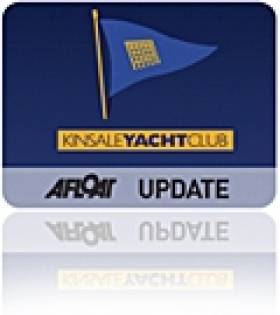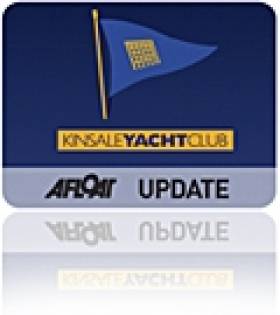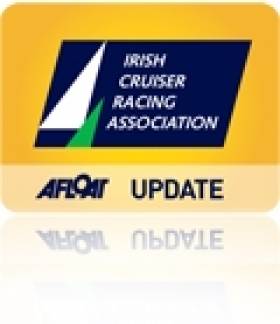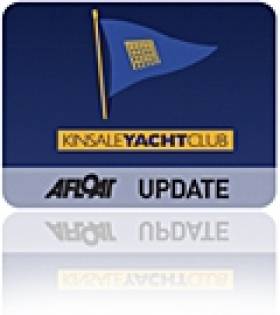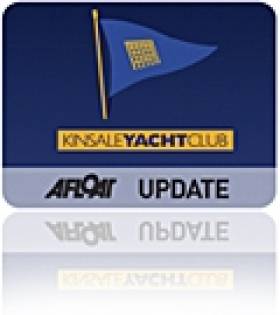Displaying items by tag: Sovereign's Cup
Recently crowned National champion Anthony O'Leary had to be content with second in yesterday's coastal course of the Sovereign's Cup when Neil White's Independent Bear bested the Royal Cork champion in the opening race of the four day regatta. Ten boats are competing in Class Zero.
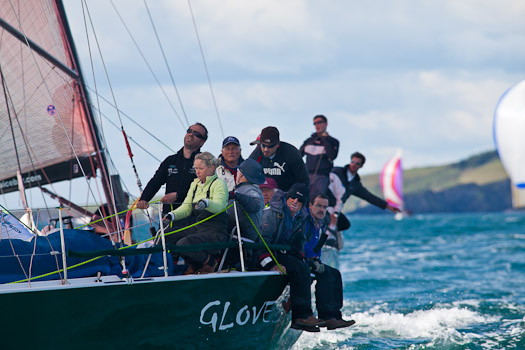
Gloves Off, third in Class Zero. Photo: Bob Bateman
Waterford Harbour's Shane Statham leads Cruiser TwoI IRC after the first two windward-leeward races. The opening races were sailed in 12-15 knot perfect north-westerly breezes allowing the Kinsale event to live up to its pre-event billing as the south coast's biggest and best sailing event of 2011. 23 boats are competing in Class two.
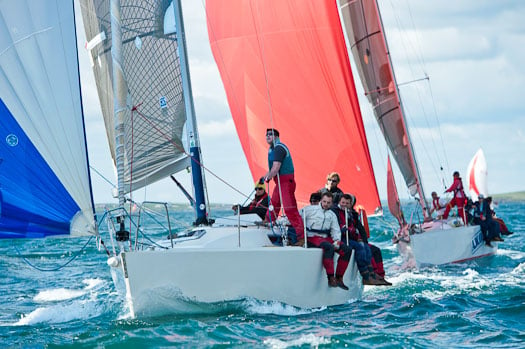
Tight racing with the J109s. Photo: Bob Bateman
In Class One, last weekend's Irish Cruiser Racing Association champion, Pat Kelly's J109 Storm from Howth, ended in fifth place. Rival Cork sistership Jelly Baby took the honours. 21 are competing.
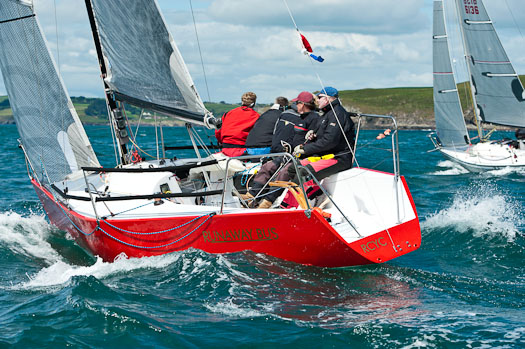
Quarter ton action. Photo: Bob Bateman
In Class 3 IRC (the Quarter ton Class) Eamonn Rohan's Anchor Challenge has the lead from Aguilla (Rob Gray) with Tiger (Kenefick/Kenefick/O'Brien) now third. Racing continues this morning and continues through til Saturday. 12 are competing.
Provisional (overall) results after day one – Class 0 IRC (Coastal): 1st Independent Bear (N White); 2nd Antix; 3rd Gloves Off (K Twomey).
Class 1 IRC (Coastal): 1st Jelly Baby (Nagle and O'Mahony); 2nd EOS (Dave Scott); 3rd Jetstream (Redden Bros). Class 2 IRC: 1st Slack Alice (Shane Strattan); 2nd Yanks $ Francs (Vinnie O'Shea); 3rd White Mischief (Timothy Goodbody).
Class 3 IRC (Quarter ton Class): 1st Anchor Challenge (Eamonn Rohan); 2nd Aguilla (Rob Gray); 3rd Tiger (Kenefick/Kenefick/O'Brien).
Class 5 IRC: 1st. Samba (John and Pat Downing) 2nd Orna (Philip Dilworth). 3rd. VSOP: (Donal McCarthy).
Keel Designs from Down Under Competing in Sovereign's Cup
Torpedoes and bulbs will be a topic of conversation in Kinsale this week at the Sovereign's Cup. The much sought after Kiwi Quarter tonner, Black Fun that competed in last week's ICRA Nats is entered for the regatta and eagle eyed photographer Bob Bateman snapped the quarter tonner in the Royal Cork boat park.

Acoording to Wicklow based yacht designer Mark Mills, the magic behind any bulb is in separating the two functions of a keel: low vertical centre of gravity (vcg) and lift. A fin keel usually by the time it has enough lead in it for stability will be larger than required for lift (see the standard 1/4 ton keel). The bulb gets one job done by getting the most weight down low, while the fin can be sized for the right amount of lift - as long as that is enough to keep the bulb attached.
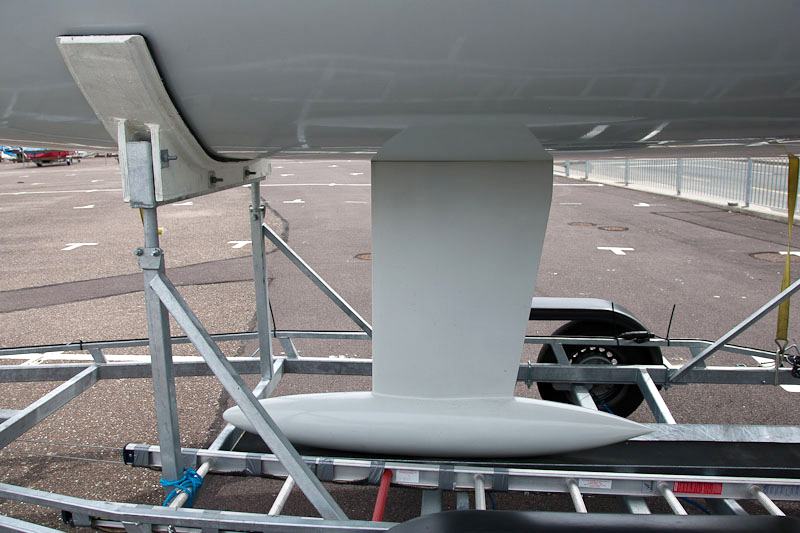
Bulb keel technology on Black Fun
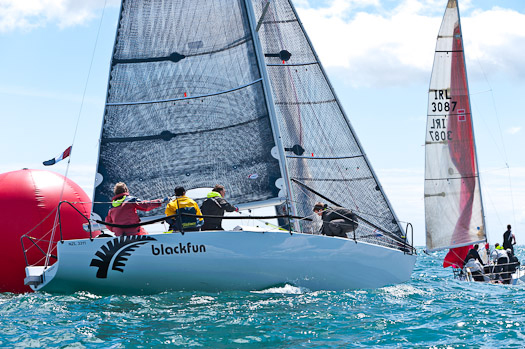
Black Fun puts her bulb to good use off Roches Point
Quarter Tonners Heading for Sovereigns Cup and ICRA Champs
Up to 25 Quarter Tonners have signed up for Cork harbour's Irish Cruiser (ICRA) National Championships and the Sovereigns Cup in Kinsale – only a week separates the two fixtures. (Latest Sovereigns Cup news here)
The budget-minded class has been back building numbers steadily since 2001 when Peter Morton revived the class on the south coast of England. Now over 40 boats compete in Britain and up to 10 will visit Cork this summer after a successful trial here two years ago.
From June 17th they'll go head to head with a number of hot Irish campaigns that have emerged in the last 12 months, including the host port's "Tiger" (O'Brien, Kenefick and Kenefick), Eamon Rohan's recently refurbished Anchor Challenge and Dún Laoghaire's Supernova, skippered by Ken Lawless.

The crew of Anchor Challenge Complete a gybe. Photo: Bob Bateman
For this year's event, some of these dated 24-26 footers are being pulled from hedgerows and fields rather than building new ones.
Last raced in the 1980s, others are getting the full make-over and have been extensively remodelled for today's IRC handicap rule.
"Budget sailing with five friends, that's the ethos", claims Kinsale skipper Ian Travers about the style of the passe class.
The current fleet contains boats from €6,000 to €30,000, the more expensive boats having extensive optimisation and new sail plans.
It's well within the rules to alter rudders and keels but hull shapes must stay original.
To qualify to race in the Quarter Ton cup, a boat must fall within the old IOR rule or be a production boat derivative. This means many mainstream class-three craft such as Farr 727s, GK24s, Starflash 26s and Boleros all qualify.
Travers reckons therefore a potential Irish fleet could reach 50 boats, if enough owners showed interest.
One boat of particular interest in June will be "Black Fun" a fully refurbished and IRC optimised 1977 Laurie Davidson- designed Quarter Tonner.
Back then she was the top Quarter Tonner in New Zealand but for financial reasons did not make the journey to Finland to compete in the Quarter Ton Cup that year. Now, 34 years later, the current owners are shipping her from New Zealand to compete in this year's cup in Cowes in July but beforehand will compete in both Irish regattas as warm-ups.
And in further good news for the ICRA event a west coast cruiser fleet have confirmed that at least 15 boats will be entering the national championships.
Irish Cruiser Racer Champs Shaping up for Cork Harbour
An exciting addition to the 2011 Nationals is the visit of up to 12 top boats from the UK Quarter Ton fleet. This is a class based in Cowes, consisting of 1970-1980s old IOR rule boats lovingly restored to within an inch of their lives and sailed by their owners many of whom are as vintage as their boats - la creme de la creme! They have begun to make an annual pilgrimage to southern Irish waters in recent years attracted by the quality of Cork Week and Sovereign's Cup and ICRA are delighted to welcome them to the Irish Nationals.
Unbelievably one of these old quarter tonners, the beautiful Davidson designed Black Fun, is presently on a container ship on her way from Wellington New Zealand to these shores to take to take her chances against the local opposition. Black Fun is one of the early entries to the ICRA nationals.
These visiting boats will provide stiff competition to local boats such as Neil Kennefick and Joxer O Brien's Tiger, Eamon Rohan's new Farr designed Anchor Challenge, Jimmy Nyhan's Outrigger and Ian Traver's Bandit.
ICRA has responded to this development by providing new Open Quarter Ton Trophies to cater for this fleet and its professional participation. The visitors will race in division 3 for the new trophies alongside the regular fleet sailing under standard ICRA regulations.
Division Zero is shaping up very well with entries from such leading boats as Anthony O Leary's Antix and Robert Davies Roxy V1 of Rolex Commodore's Cup winning fame as well as the beautiful Mills 36 Crazy Horse, of Nobby Reilly and Alan Chambers, the Conor Phelan's Royal Cork Ker 37 Jump and the still potent Corby 39 Gloves Off of Kieran Twomey. Division 1 will see loyal supporters like the Mills 30, Raptor and and the Corby 33 Rockabill do battle with local boats such as Jelly Baby and True Pennance.
Division 2 promises top Class competition with the former Colwell and Murphy owned national champion, the Corby 25 Kinetic, now Azure and sailing under the burgee of Kinsale YC and helmed by Brian Goggin competing with a number of sister boats including Vinny O Shea's Yanks $ Ffranks, Denis Coleman's Thunderbird, Conor Ronan's Ruthless from Sligo YC as well as many others such as Dux, Slack Alice, Zoom, Indigo, Sunburn, Xebec and Kodachi.
There is a Division 4 introduced for the first time this year with SCORA putting up the trophies.This is in response to a strong local Cork Harbour fleet in this Band.
The ICRA Corinthian Cup for Non-Spinnaker Boats comes to the South Coast also for the first time and a second Cup has been added to cater for both IRC and ECHO divisions.
This is a real opportunity for non spinnaker boats to compete in a Regatta of this calibre and a big fleet is expected.
Entry fees for boats entered by 29th April are reduced from €175 to €125 so get those entries in during April to take advantage of this incredible value. Reduced lift in and out fees and a great accomodation package are in place with Carrigaline Court Hotel.
All the latest Irish Cruiser Racing Association (ICRA) News
Sovereigns Cup Aiming for 140 Entries
Entries are coming in at a good pace for The Sovereign's Cup the South coast sailing event takes place from 22nd-25th June 2011 in the outer harbour of Kinsale, Co Cork.
"We are delighted with the entry level to date and are now encouraging boats to enter The Sovereign's Cup on our website www.sovereignscup.com or by calling Kinsale Yacht Club directly on (021) 4773433. Already, skippers are beginning to plan their sailing events for the year and we hope that they will favourably consider us here in Kinsale," said Gary Horgan, Regatta Director.
"Additionally, this year, the Dun Laoghaire to Dingle race and ICRA Championships in Cork just before The Sovereign's Cup should act as good feeders as boats will be down south. As well as the excellent sailing conditions, race management and social programme ashore, there is a good discounted entry fee for the first 100 entries, which is already proving very attractive to entrants. Also, we are encouraging people to start thinking about their travel and accommodation plans and are delighted that the Cork Swansea ferry will enable more sailors to access Kinsale easily from the UK," he added.
The Sovereign's Cup was established in 1995 as and has been a very successful and hugely popular cruiser regatta. The biennial event attracts over 140 boats from all over Ireland and the UK who compete for the prestigious Sovereign's Cup for best all round score in IRC and The Portcullis Trophy for best progressive handicap.
There are many Classes for entry; including Class 0, 1, 2, 3, 4 and two White Sails classes. Also, the Quarter Ton Class Championships will be taking place during the Sovereign's Cup, bringing many new visitors to Kinsale from the South of England and Wales in particular.
According to Ian Travers of the Sovereign's Cup Committee at KYC, interest has been phenomenal and he has received plenty of calls from UK and Irish owners expressing their interest.
"Also, I have received confirmation that a quarter tonner named 'Black Fun' is to be shipped from New Zealand to Europe this year and is intent on making it to Kinsale for the Sovereign's Cup! We are confident that there will be around 25-30 quarter tonners participating in the Sovereign's Cup this year," said Ian Travers.
For more information on The Sovereign's Cup, contact Kinsale Yacht Club on (021) 4773433 www.kyc.ie or www.sovereignscup.com
Take a look back at Bob Bateman's photos from Sovereigns Cup 2003, Sovereigns Cup 2005 and Sovereigns Cup 2007 in our photo reviews
Click this link for all the lastest Sovereigns Cup news from Afloat.ie
Looking Back at Photos from the Sovereign's Cup 2003
Sailing Entries for the 2003 Sovereign's Cup regatta hit the 100 mark as Brown Thomas and Jacobs Engineering announced that they were back on board as day sponsors. Entries from Sligo 'round to Dublin complemented the enthusiastic and popular Welsh fleet now considered 'regulars' by the club. The Gentleman's fleet successfully lobbied with OOD Bruce Matthews to wait until they had finished watching a match on TV before starting their day's race.
Bob Bateman's images of the 2003 event are BELOW:
National Award for Irish Cruiser Racing Association (ICRA)
In the three decades and more of the Mitsubishi Motors/Irish Independent "Sailing Club of the Year" assessments, there has never been an organization only seven years old winning the title.
In fact, seniority has often won the day, though in a country in which the oldest sailing clubs date from 1720 (Royal Cork) and 1770 (Lough Derg), it's difficult to find clubs and associations which are anything less than centenarians, let alone not yet in double figures.
But it was only as recently as June 2003 that the Irish Cruiser Racing Association came into being. It was at the biennial Sovereign's Cup series in Kinsale that Fintan Cairns of Dun Laoghaire, enthusiastically supported by the late Jim Donegan of Cork and other key personnel, successfully launched the idea of a nationwide organisation to co-ordinate the racing sport of "boats with lids".
At the time, it was a leap of vision. Having successfully headed Dublin Bay Sailing Club at a time of rapid growth, he was able to see the picture more clearly than those who reckoned that offshore racing organisations should be related to bodies of water rather than a land mass, for all that we're on an island.
Then too, the new association was envisaged as using established clubs and their facilities to stage its championship. In other words, the ICRA organising team would be the travelling people of the Irish sailing scene. On top of that, handicap competition with cruiser-racers was derided as "truck racing" by the white hot one design and dinghy sailors.
Yet the idea took hold, and the annual championship was successfully staged at venues as various as Crosshaven, Tralee, Howth, Kinsale and Dun Laoghaire, with Denis Kiely the essential ace number-cruncher in the back office. And in May 2010, with the mighty machine of the Royal St George YC in Dun Laoghaire providing the administrative centre, the Liebherr Irish Cruiser Nationals in Dublin Bay attracted a fleet of 117 boats, with great sailing.
On that event alone, ICRA would have been among the front runners for Club of the Year. But the best was yet to come. In recessionary times, getting a three boat team together to make a worthwhile challenge for the biennial Rolex International Commodore's Cup was a matter of making the best of limited resources. But ICRA – currently under the leadership of Barry Rose of Cork - was up to the job.
The team of Anthony O'Leary's Antix, Dave Dwyer's marinerscove.ie, and Rob Davis and Andrew Creighton's Roxy 6, had a convincing win. Thus ICRA in one season had catered very well for general run of boats and crews at home, and had come out tops at the top level internationally. It doesn't get better than that, and we salute them as Sailing Club of the Year 2011.
Kinsale Yacht Club Announces 2011 Sovereign's Cup
Details of the 2011 Sovereign's Cup were announced at a reception at Kinsale Yacht Club, hosted by Regatta Director, Gary Horgan. The Sovereign's Cup takes place from 22nd-25th June 2011 in the outer harbour of Kinsale which prides itself with excellent sailing conditions, as well as an extensive social programme ashore.
The Sovereign's Cup was established in 1995 as a biennial event and has been a very successful and hugely popular cruiser regatta, with over 140 boats from all over Ireland and the UK competing for the prestigious Sovereign's Cup for best all round score in IRC and The Portcullis Trophy for best progressive handicap.
There are many Classes for entry; including Class 0, 1, 2, 3, 4 and two White Sails classes. Also, the Quarter Ton Class Championships will be taking place during the Sovereign's Cup, bringing many new visitors to Kinsale from the South of England and Wales in particular.
Eamonn Rohan in Blondie IV a Mills Design King 40, claimed the 2009 Sovereign's Cup as the 2009 Portcullis Trophy was awarded to Chapman / Reilly's Crazy Horse. Anchor Challenge captured Class 3-IRC and the Quarter Ton Class and was awarded the Keane's Jewellers Quarter Ton Perpetual Trophy.

The Kinsale Yacht Club committee behind the 2011 Sovereigns Cup
"We have already received a number of entries for The 2011 Sovereign's Cup in June and we will be stepping up our sponsorship and communications programme as the months advance," said Gary Horgan, Race Director. "We are very grateful to Kinsale Yacht Club, the Race Management team and all the volunteers who get involved with the organisation of the Sovereign's Cup as we are working hard to organise an excellent programme both on and off the water. We are encouraging people to start thinking about their travel and accommodation plans and are delighted that the Cork Swansea ferry will enable more sailors to access Kinsale easily from the UK," he added.
Sovereign's Cup
The 2009 Sovereign's Cup Regatta for Cruisers from Wednesday June 24th to Saturday June 27th in the historic town of Kinsale. There will be 8 races in 4 days of top level competition in both IRC and Echo, combined with a renowned social programme, making the Sovereign's Cup a truly unique event.


























